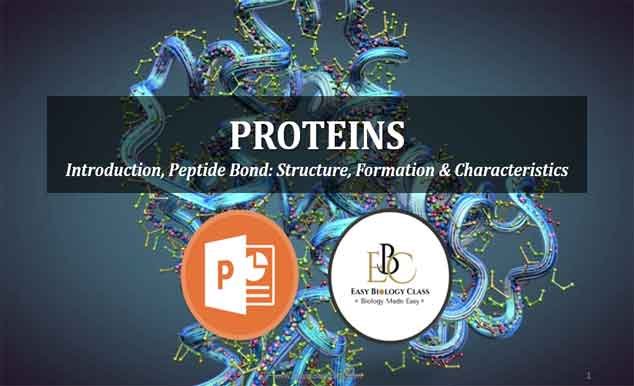Characteristics of Peptide Bond PPT: A peptide bond is a covalent bond formed between the carboxyl group of one amino acid and the amino group of another, releasing a molecule of water in the process. This reaction is known as a dehydration synthesis or condensation reaction. Peptide bonds are planar and rigid due to partial double bond character, which restricts rotation around the bond and contributes to the stability of protein structures. The bond is generally stable under physiological conditions and can only be broken by enzymatic action or extreme chemical conditions. The rigidity of peptide bonds plays a crucial role in maintaining the specific folding and three-dimensional structure of proteins. Despite their stability, peptide bonds are flexible enough to allow limited motion between adjacent amino acids, aiding in the formation of secondary structures such as alpha-helices and beta-sheets. Overall, the peptide bond is fundamental to protein architecture and biological function.
Biochemistry Notes | Biochemistry PPT
Characteristics of Peptide Bond PPT
Proteins: Introduction, Peptide Bond: Structure, Formation & Characteristics
Proteins:
- Most abundant organic molecules in living systems.
- Found in every part of the cell.
- Constitute about 50% of cellular dry weight.
- Form the basis of structure and function of life.
- The term “protein” originated from the Greek word “proteios,” meaning “holding the first place”.
- First termed by Mulder (Dutch chemist) in 1838.
- Mulder used the term for high molecular weight nitrogen-rich substances in animals and plants.
What are Proteins?
- Polymers of amino acids, specifically L-α-amino acids.
- Range in size from three to thousands of amino acids.
- Amino acids are joined covalently through PEPTIDE BONDS.
N-Terminal and C-Terminal of Protein
- In a peptide, the amino acid residue with a free α-amino group is the amino-terminal or N-terminal.
- The residue with a free α-carboxyl group is the carboxyl-terminal or C-terminal.
The pI of Proteins
- Amino and carboxyl groups of non-terminal amino acids are joined in peptide bonds and do not ionize.
- Each polypeptide has one free carboxyl group and one free amino group at the ends, which can ionize.
- R groups contribute to the overall acid-base properties of a peptide.
- Polypeptides have an isoelectric pH (pI).
- At pI, proteins do not move in an electric field.
- Isoelectric focusing (a protein purification technique) is based on this principle.
Sub-units of Protein
- Some proteins have a single polypeptide chain.
- Others have multiple subunits with many peptides, which may be identical or different.
- Example: Hemoglobin has four polypeptide chains: two identical α chains and two identical β chains.
Peptide Bond
- An amide linkage.
- A single bond.
- Rigid and planar.
- The α-carbon atoms in adjacent amino acid residues are separated by three covalent bonds (Cα – C – N – Cα).
- The peptide C–N bond is shorter than a C–N bond in a simple amine.
- Atoms associated with the peptide bond are co-planar.
- There is resonance or partial sharing of two pairs of electrons between the carbonyl oxygen and the amide nitrogen.
- The oxygen has a partial negative charge, and the nitrogen has a partial positive charge, resulting in a small electric dipole.
- The C–N bond cannot rotate freely due to its partial double bond character.
- Rotation is permitted only at N–Cα and Cα–C bonds.
- The six atoms of the peptide bond are in a single plane, with the oxygen of the carbonyl group and the hydrogen of the amide nitrogen in a trans configuration.
Ramachandran Plot
- Free rotation is not permitted around the peptide bond.
- Rotation is allowed only at N–Cα and Cα–C bonds.
- The bond angle resulting from rotation at N–Cα is labeled φ (phi).
- The bond angle resulting from rotation at Cα–C is labeled ψ (psi).
- By convention, both φ and ψ are 180° when the polypeptide is fully extended and all atoms are in the same plane.
- φ and ψ can have values between -180° and +180°.
- Steric hindrance between atoms in the polypeptide backbone and amino acid side chains restricts many values.
- Allowed values for φ and ψ are shown in a Ramachandran Plot (ψ versus φ), introduced by G.N. Ramachandran.
- The Ramachandran plot helps predict the possible three-dimensional conformations of peptide chains.
References
- Berg, J.M. and Tymoczko, J.L., 2018. Stryer biochemie (Vol. 8). Heidelberg: Springer Spektrum.
- Nelson, D.L., Lehninger, A.L. and Cox, M.M., 2008. Lehninger principles of biochemistry. Macmillan.
- Voet, D. and Voet, J.G., 2010. Biochemistry. John Wiley & Sons.
How to Download PPT from EasyBiologyClass?

I hope you found this PPT on Characteristics of Peptide Bond is informative and beneficial. Your feedback and comments would be greatly appreciated. Whether you have suggestions, questions, or thoughts to share, I would be delighted to hear from you. Engaging with your comments helps me continue to produce high-quality content in Biology. Please feel free to leave a comment below. Thank you for your support.
Regards: Admin, EasyBiologyClass
